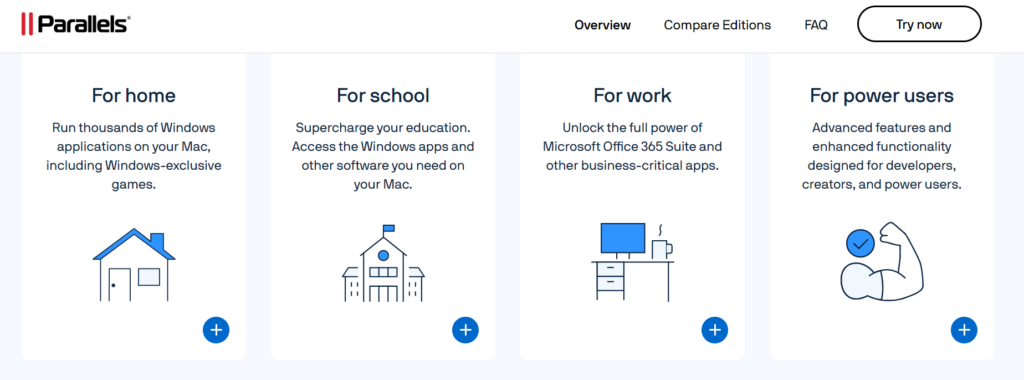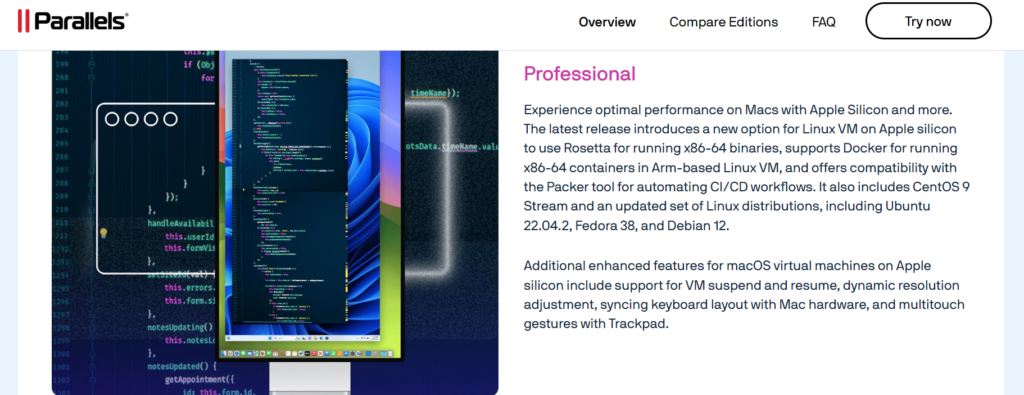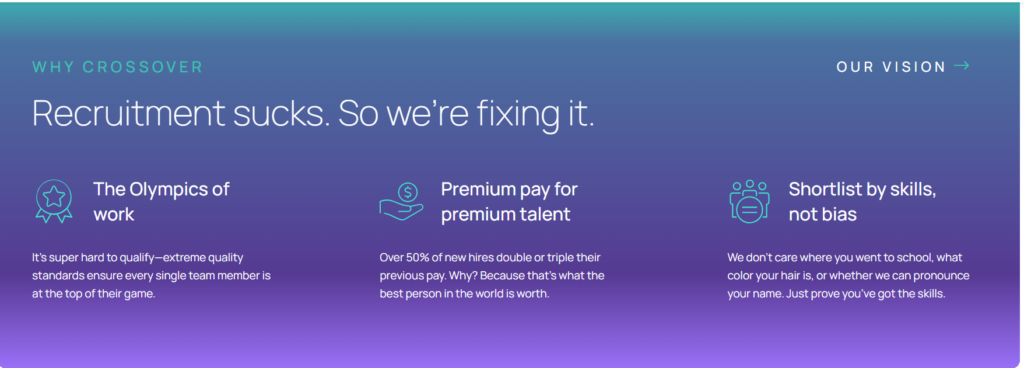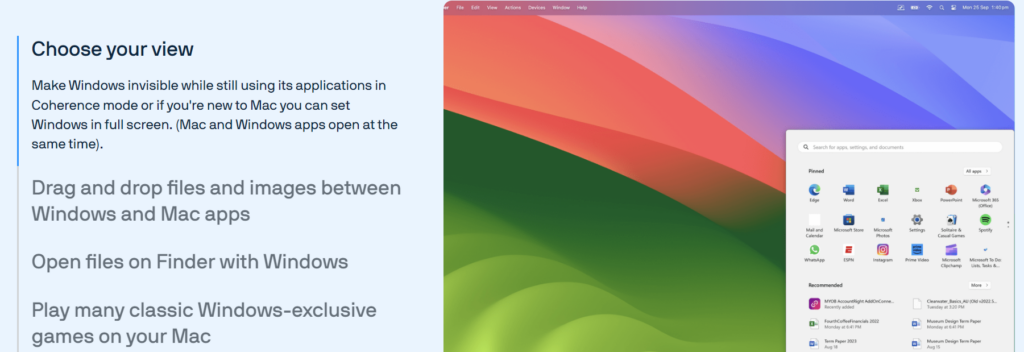With the growing demand for seamless cross-platform integration, Mac users often face challenges when running Windows applications on macOS.
Whether it’s for work, gaming, or specific software, having the ability to run Windows programs on a Mac has become increasingly essential.
Two popular solutions that cater to this need are Parallels and CrossOver. Both tools offer unique approaches to achieving this, but which one is the better option for you?
In this comprehensive comparison, we’ll explore the key differences, features, pricing, and more to help you make an informed decision.
Overview of Parallels and CrossOver
Overview of Parallels

Parallels is one of the most well-known virtualization software solutions that allow Mac users to run Windows and other operating systems within a virtual environment.
Launched in 2006, Parallels Desktop has continually evolved, offering Mac users a powerful tool to run Windows applications without needing to reboot their system.
By creating a virtual machine, Parallels lets users run the entire Windows OS alongside macOS, making it ideal for those who need a seamless and complete Windows experience.
[button-red url=”https://digitalmarketerr.com/recommends/parallels/” target=”_blank” position=”center”]🔥Try Parallels Now[/button-red]
Key Use Case: Parallels is perfect for users who need to run full-fledged Windows applications, especially those with high hardware requirements, such as engineers, developers, or gamers. Its ability to run resource-heavy apps makes it a preferred choice for professionals.
Overview of CrossOver

CrossOver, developed by CodeWeavers, takes a different approach. Instead of creating a virtual machine to run the entire Windows operating system, CrossOver utilizes a compatibility layer based on the Wine project.
This allows users to run Windows applications directly on macOS without installing Windows. CrossOver focuses on running individual apps rather than the whole OS, which can be more lightweight and less resource-intensive.
[button-red url=”https://www.crossover.com/” target=”_blank” position=”center”]🔥Try CrossOver Now[/button-red]
Key Use Case: CrossOver is an excellent solution for users who want to run specific Windows applications without the overhead of a full Windows installation. This can be especially useful for individuals looking to run productivity tools, certain games, or legacy software on their Mac.
Features of Parallels and CrossOver
Features of Parallels

Virtual Machine (VM) Support: Parallels is known for creating a complete virtual machine, allowing users to run Windows or other operating systems like Linux alongside macOS. This is particularly useful for professionals who need full access to Windows apps and features.
Coherence Mode: Parallels offers Coherence Mode, a feature that allows users to run Windows applications as if they were native macOS apps. The Windows desktop disappears, and apps from both OSes can run side by side seamlessly.
[button-red url=”https://digitalmarketerr.com/recommends/parallels/” target=”_blank” position=”center”]🔥Try Parallels Now[/button-red]
Performance: Parallels is optimized for high performance, making it ideal for resource-heavy applications like Adobe Creative Suite, Microsoft Office, and even 3D games. It provides an excellent experience for users who require the best of both worlds—macOS and Windows.
Integration with macOS: Parallels integrates deeply with macOS features like Touch Bar support, trackpad gestures, and Retina display optimization.
You can drag and drop files between the two operating systems, copy-paste seamlessly, and share folders effortlessly.
[button-red url=”https://digitalmarketerr.com/recommends/parallels/” target=”_blank” position=”center”]🔥Try Parallels Now[/button-red]
Windows and Linux Support: Parallels allows users to run not just Windows but also various Linux distributions within macOS. This multi-OS capability makes Parallels a versatile tool for developers and testers.

Automated Tools: Parallels comes with an array of automation tools, such as the ability to automatically reclaim disk space and easily manage VM configurations, making it user-friendly for those who aren’t highly technical.
Gaming Compatibility: Parallels Desktop is optimized for gaming, offering DirectX and OpenGL support. This makes it a solid choice for gamers who want to run Windows-exclusive titles on macOS.
Features of CrossOver

No Windows OS Installation Required: One of the most significant advantages of CrossOver is that it doesn’t require a full Windows installation. Instead, it runs Windows applications through its Wine-based compatibility layer.
This makes CrossOver lighter and faster, as there’s no need to allocate resources to an entire virtual machine.
Easy Installation of Windows Apps: CrossOver simplifies the process of installing Windows applications on macOS.
It provides a large library of “bottles” (which are custom configurations for specific apps), making it easy to install and run popular Windows software like Microsoft Office, Adobe Photoshop, and many games.
[button-red url=”https://www.crossover.com/” target=”_blank” position=”center”]🔥Try CrossOver Now[/button-red]
Lower Resource Usage: Because CrossOver doesn’t need to run a virtual machine, it consumes significantly fewer resources compared to Parallels.
This can be a major benefit for users with older Macs or those who don’t want to allocate large amounts of RAM and CPU to running Windows applications.
[button-red url=”https://www.crossover.com/” target=”_blank” position=”center”]🔥Try CrossOver Now[/button-red]
Customizable Wine Bottles: CrossOver allows users to create custom “bottles” for each application, providing unique settings and configurations that can be tailored to specific needs. This flexibility is excellent for users who need to run legacy or less common software.
Cross-Platform Support: In addition to macOS, CrossOver supports Linux and ChromeOS, making it a versatile option for users who operate across multiple platforms.
Frequent Updates: CrossOver regularly updates its software to improve compatibility with newer versions of macOS and Windows applications. This ensures users can keep running the latest software without interruptions.

Gaming: While CrossOver doesn’t provide the same level of gaming optimization as Parallels, it still offers decent support for running Windows games on macOS. It is particularly well-suited for older games that don’t require high-end hardware.
Pricing Comparison of Parallels and CrossOver
Parallels Pricing:
Parallels offers several pricing tiers, catering to different types of users. The standard edition is priced at around $99.99 per year, while the Pro Edition (which includes more advanced tools and higher performance capabilities) costs $119.99 per year.
A perpetual license is available for $129.99, but it only includes updates for the current version.
Parallels also provides a free trial, so users can test the software before committing to a subscription or one-time payment.

[button-red url=”https://digitalmarketerr.com/recommends/parallels/” target=”_blank” position=”center”]🔥Try Parallels Now[/button-red]
CrossOver Pricing:
CrossOver offers more affordable pricing options compared to Parallels. The standard CrossOver subscription costs around $59.95 per year, with a one-time purchase option available for $499.95.
CrossOver also includes a 14-day free trial, allowing users to try out the software before making a decision.

[button-red url=”https://www.crossover.com/” target=”_blank” position=”center”]🔥Try CrossOver Now[/button-red]
Pros and Cons
| Features | Parallels | CrossOver |
|---|---|---|
| Ease of Use | User-friendly with easy setup | Requires some technical setup |
| Resource Usage | Higher due to virtual machines | Low resource consumption |
| Performance | High performance for heavy apps | Moderate performance |
| Full OS Integration | Yes (Windows, Linux, etc.) | No (Only Windows apps) |
| App Compatibility | Broad range, including new games | More limited, especially newer apps |
| Pricing | Higher subscription cost | More affordable |
FAQs
What is the main difference between Parallels and CrossOver?
Parallels creates a full virtual machine to run Windows on macOS, while CrossOver uses a Wine-based layer to run Windows apps without the need to install the full OS.
Which is better for gaming, Parallels or CrossOver?
Parallels is generally better for gaming due to its support for DirectX and OpenGL, making it ideal for running modern games. CrossOver is more suitable for older or less resource-demanding games.
Can CrossOver run all Windows applications?
No, CrossOver has limited compatibility compared to Parallels, especially for newer or more complex applications that require specific Windows libraries.
Is Parallels more resource-intensive than CrossOver?
Yes, because Parallels runs a full virtual machine, it requires more system resources than CrossOver, which only runs the specific Windows app.
Does CrossOver support other operating systems like Linux?
Yes, CrossOver is compatible with Linux and ChromeOS in addition to macOS.
Conclusion
When deciding between Parallels and CrossOver, it’s essential to consider your specific use case, performance requirements, and budget.
Both solutions enable Mac users to run Windows applications, but they take vastly different approaches, which directly impacts their usability, compatibility, and system performance.
Parallels is an ideal choice for users who need the full power and functionality of a Windows operating system on their Mac. It offers a comprehensive, high-performance virtualization environment that allows you to run Windows, Linux, and other operating systems alongside macOS.
This is especially important for professionals, gamers, and power users who need access to resource-heavy software such as Microsoft Office, Adobe Suite, or high-end PC games.
The integration features, like Coherence Mode, make Parallels a seamless solution for those who regularly switch between macOS and Windows applications.
The trade-off, however, is that Parallels requires more system resources, making it more demanding on your hardware, particularly if you run multiple virtual machines or resource-intensive programs simultaneously.
On the other hand, CrossOver provides a simpler, more lightweight alternative for users who only need to run specific Windows applications without the need to install the entire operating system.
Its use of Wine-based technology means you can run Windows apps directly on macOS without the overhead of virtualization, making it an excellent option for users with older hardware or those looking for a more affordable, less resource-heavy solution.
CrossOver is especially appealing for casual users who want to run productivity software or older games, but it does have limitations when it comes to compatibility with newer or more complex Windows applications.
Some apps may require custom configurations or might not work at all, which can be a drawback for those with more extensive needs.
Performance is another significant differentiator between the two. Parallels excels in performance, especially for users who need to run high-end applications or require a seamless experience with Windows applications.
The fact that it supports advanced features like DirectX and OpenGL makes it superior for gaming and professional tasks. CrossOver, by contrast, shines in its lower resource consumption, offering a solution that doesn’t slow down your system as much but with a trade-off in application compatibility and performance, particularly for more modern software.
In terms of pricing, Parallels is a premium solution that comes with a higher cost, especially if you opt for the Pro or Business editions, which offer advanced features and more robust support for professionals.
[button-red url=”https://digitalmarketerr.com/recommends/parallels/” target=”_blank” position=”center”]🔥Try Parallels Now[/button-red]
While it is pricier, Parallels justifies the cost with its extensive feature set, high performance, and seamless integration with macOS. CrossOver, in contrast, offers a more budget-friendly option.
Its annual subscription is significantly lower than Parallels, and there’s even a one-time purchase option for users who prefer a lifetime license.
For users on a tight budget or those who don’t require full Windows functionality, CrossOver presents an affordable solution with no recurring costs if the one-time purchase option is chosen.
In conclusion, choose Parallels if you need a powerful, full-fledged virtual machine to run Windows and other operating systems on your Mac.
[button-red url=”https://www.crossover.com/” target=”_blank” position=”center”]🔥Try CrossOver Now[/button-red]
It is the best choice for power users, professionals, and gamers who need access to resource-intensive software and high-performance apps. Its seamless integration with macOS, Coherence Mode, and advanced features make it a robust solution for those who require a Windows experience that feels native on macOS.
However, choose CrossOver if you’re looking for a more affordable, lightweight solution to run specific Windows applications without the need for a full virtual machine.
It’s perfect for casual users, students, or anyone who only needs to run a few key Windows apps without sacrificing system performance or dealing with the complexities of running a full OS. Keep in mind that its compatibility is more limited compared to Parallels, so it may not work with every Windows application.
Ultimately, the choice between Parallels and CrossOver comes down to the scope of your needs. If you require the full Windows experience with top-notch performance, Parallels is worth the investment.
If you’re focused on cost and only need a few specific apps, CrossOver is the smarter, more budget-conscious option.
